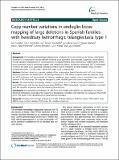Por favor, use este identificador para citar o enlazar a este item:
http://hdl.handle.net/10261/94767COMPARTIR / EXPORTAR:
 SHARE SHARE
 CORE
BASE CORE
BASE
|
|
| Visualizar otros formatos: MARC | Dublin Core | RDF | ORE | MODS | METS | DIDL | DATACITE | |

| Título: | Copy number variations in endoglin locus: mapping of large deletions in Spanish families with hereditary hemorrhagic telangiectasia type 1 |
Autor: | Fontalba, Ana; Fernández-Luna, Jose L.; Zarrabeitia, Roberto; Recio-Poveda, Lucía ; Albiñana, Virginia CSIC; Ojeda-Fernández, María Luisa CSIC; Bernabéu, Carmelo CSIC ORCID ; Alcaraz, Luis A.; Botella, Luisa María CSIC ORCID | Palabras clave: | Hereditary hemorrhagic telangiectasia (HHT) Endoglin deletions Multiplex ligation PCR assisted assay (MLPA) Copy number variation (CNV) arrays Alu repetitive sequences |
Fecha de publicación: | 25-nov-2013 | Citación: | BMC Medical Genetics 14(1) : 121- (2013) | Resumen: | Abstract Background The hereditary hemorrhagic telangiectasia syndrome (HHT), also known as the Rendu–Osler-Weber syndrome is a multiorganic vascular disorder inherited as an autosomal dominant trait. Diagnostic clinical criteria include: epistaxis, telangiectases in mucocutaneous and gastrointestinal sites, arteriovenous malformations (AVMs) most commonly found in pulmonary, hepatic and cerebral circulations, and familial inheritance. HHT is transmitted in 90% of the cases as an autosomal dominant condition due to mutations in either endoglin (ENG), or activin receptor-like kinase 1 (ACVRL1/ALK1) genes (HHT type 1 and 2, respectively). Methods We have carried out a genetic analysis of four independent Spanish families with HHT clinical criteria, which has permitted the identification of new large deletions in ENG. These mutations were first detected using the MLPA technique and subsequently, the deletion breakpoints were mapped using a customized copy number variation (CNV) microarray. The array was designed to cover the ENG gene and surrounding areas. Results All tested families carried large deletions ranging from 3-kb to 100-kb, involving the ENG gene promoter, several ENG exons, and the two downstream genes FGSH and CDK9. Interestingly, common breakpoints coincident with Alu repetitive sequences were found among these families. Conclusions The systematic hybridization of DNA from HHT families, with deletions or duplications, to custom designed microarrays, could allow the mapping of breakpoints, coincident with repetitive Alu sequences that might act as “hot spots” in the development of chromosomal anomalies. | Versión del editor: | http://dx.doi.org/10.1186/1471-2350-14-121 | URI: | http://hdl.handle.net/10261/94767 | DOI: | 10.1186/1471-2350-14-121 | ISSN: | 1471-2350 | E-ISSN: | 1471-2350 |
| Aparece en las colecciones: | (CIB) Artículos |
Ficheros en este ítem:
| Fichero | Descripción | Tamaño | Formato | |
|---|---|---|---|---|
| 1471-2350-14-121.xml | 74,97 kB | XML | Visualizar/Abrir | |
| 1471-2350-14-121.pdf | 1,75 MB | Adobe PDF |  Visualizar/Abrir | |
| 1471-2350-14-121-S1.PPTX | 382,88 kB | Microsoft Powerpoint XML | Visualizar/Abrir |
CORE Recommender
PubMed Central
Citations
2
checked on 12-abr-2024
SCOPUSTM
Citations
4
checked on 15-abr-2024
WEB OF SCIENCETM
Citations
5
checked on 27-feb-2024
Page view(s)
368
checked on 19-abr-2024
Download(s)
497
checked on 19-abr-2024
Google ScholarTM
Check
Altmetric
Altmetric
Artículos relacionados:
NOTA: Los ítems de Digital.CSIC están protegidos por copyright, con todos los derechos reservados, a menos que se indique lo contrario.
